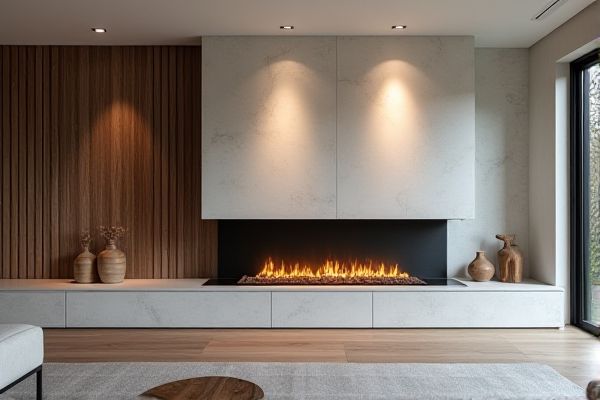
A linear fireplace offers a sleek, modern design with even heat distribution and easier installation compared to a traditional fireplace, which typically features a classic, sturdy build with a more rustic charm and requires a chimney for venting. Explore the rest of the article to discover which fireplace best suits your home's style and heating needs.
Table of Comparison
| Feature | Linear Fireplace | Traditional Fireplace |
|---|---|---|
| Design | Modern, sleek, rectangular shape | Classic, often stone or brick construction |
| Installation | Wall-mounted or built-in, requires less space | Built into masonry chimney, takes more space |
| Fuel Type | Gas, electric, or ethanol | Wood-burning or gas |
| Efficiency | High efficiency, direct vent options | Lower efficiency, heat loss through chimney |
| Maintenance | Low maintenance, no ash or soot | Requires regular chimney cleaning |
| Heat Output | Consistent and controllable heat | Variable heat, depends on wood quality |
| Cost | Higher initial cost but lower operational cost | Lower initial cost, higher ongoing fuel and maintenance |
| Environmental Impact | Cleaner burning, fewer emissions | Produces smoke and particulate matter |
| Safety | Glass front with safety features | Open flames, risk of sparks and smoke |
| Customization | Available with LED lighting and remote control | Traditional mantel and hearth options |
Introduction to Linear and Traditional Fireplaces
Linear fireplaces feature a sleek, elongated design that fits modern interiors, offering clean lines and adjustable flame settings for enhanced ambiance. Traditional fireplaces typically showcase a classic brick or stone hearth with a vertical structure, providing a rustic charm and often relying on wood-burning for heat. Both types serve as focal points but differ significantly in style, installation, and fuel options.
Design and Aesthetics Comparison
Linear fireplaces feature a sleek, contemporary design with their elongated shape and minimalist frame, enhancing modern interiors with a clean, streamlined look. Traditional fireplaces often showcase classic elements such as brick or stone surrounds and mantlepieces, serving as a warm focal point that complements rustic or vintage decor. Your choice between these styles depends on whether you prefer a bold, modern statement or a timeless, cozy ambiance in your living space.
Installation Requirements Explained
Linear fireplaces require less space and often offer flexible installation options including wall-mounting or recessed setups, making them ideal for modern homes. Traditional fireplaces demand substantial structural support, a chimney, and a hearth, leading to more complex and costly installation processes. Understanding these differences helps you choose the option that fits your home's design and your installation capabilities.
Heat Efficiency and Distribution
Linear fireplaces offer superior heat efficiency by using advanced direct vent technology that minimizes heat loss and maximizes warm air circulation throughout your room. Traditional fireplaces often lose a significant amount of heat through the chimney, resulting in lower overall heating efficiency. Your home benefits from more consistent and evenly distributed warmth with a linear fireplace compared to the localized heat output of traditional models.
Fuel Types and Options
Linear fireplaces offer versatile fuel options including natural gas, propane, and electric, providing cleaner combustion and easier installation compared to traditional wood-burning fireplaces. Traditional fireplaces primarily rely on burning wood, producing authentic flames and aromas but requiring more maintenance and proper ventilation. Gas and electric linear models enable precise flame control and reduced emissions, appealing to modern energy-efficient preferences.
Maintenance and Cleaning Needs
Linear fireplaces require less frequent cleaning due to their sealed glass fronts, which prevent dust and debris from entering the combustion chamber, unlike traditional fireplaces that produce ash and soot requiring regular removal. The glass on linear fireplaces typically needs only occasional wiping to maintain clarity, while traditional fireplaces demand extensive cleaning of soot from both the firebox and chimney to prevent buildup and fire hazards. Maintenance of traditional fireplaces often involves more labor-intensive tasks such as chimney sweeping and inspection to ensure safe operation, compared to the minimal upkeep of linear models.
Safety Features and Considerations
Linear fireplaces feature advanced safety measures such as tempered glass shields and cool-touch surfaces, reducing the risk of burns and accidental fires. Traditional fireplaces often require more caution due to open flames, flying embers, and the need for proper ventilation and regular chimney maintenance. Your choice should consider these safety aspects to ensure a secure and comfortable environment in your home.
Cost Analysis: Upfront and Ongoing
Linear fireplaces generally have higher upfront costs due to their sleek design and advanced technology, often ranging between $3,000 to $7,000 including installation. Traditional fireplaces typically cost less initially, around $2,000 to $5,000, but ongoing expenses such as chimney maintenance, wood fuel, and cleaning can increase overall expenditure. Energy efficiency in linear fireplaces reduces long-term heating costs, making them more economical over time compared to traditional wood-burning models.
Environmental Impact and Energy Use
Linear fireplaces typically use gas or electric fuel sources, offering higher energy efficiency and lower emissions compared to traditional wood-burning fireplaces that release more particulate matter and carbon monoxide. Modern gas linear fireplaces convert up to 99% of fuel to heat, reducing environmental impact by minimizing pollutants and conserving energy. Traditional fireplaces often lose substantial heat through the chimney, wasting energy and contributing to indoor and outdoor air pollution.
Which Fireplace Suits Your Space?
Linear fireplaces offer a sleek, modern design that fits well in contemporary spaces, often requiring less wall space and providing a wider viewing area. Traditional fireplaces, with their classic brick or stone surrounds, suit more rustic or historic interiors and typically need more room for installation and ventilation. Your choice depends on the style of your home, available space, and whether you prioritize modern aesthetics or traditional charm.
 homyna.com
homyna.com